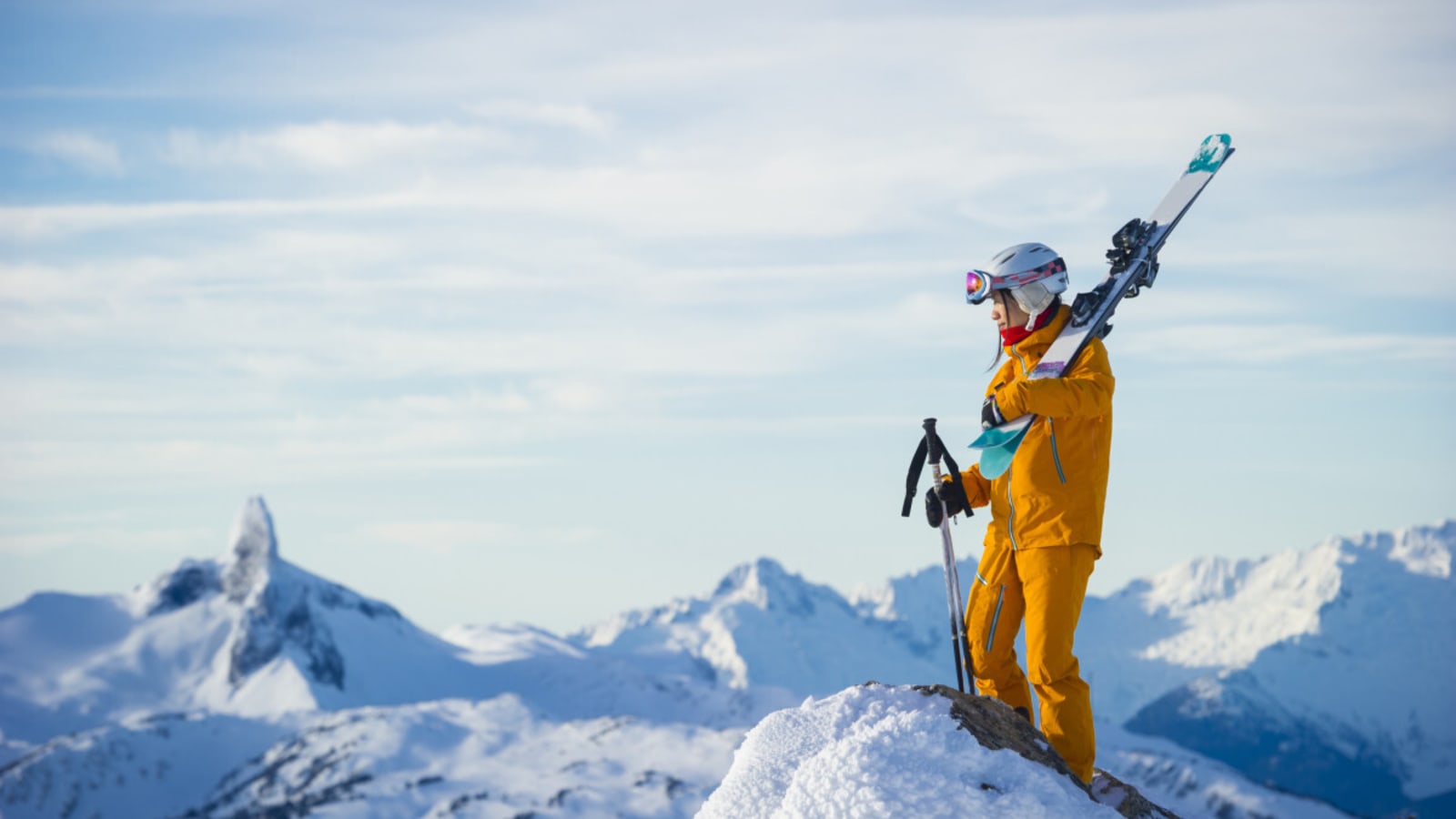
Have you heard a skier mention that they need to work on getting their "ski legs"? It's an odd phrase we use to describe the physical shape and strength we require to achieve our goals on skis, but one that paints most of the picture.
Leg strength and mobility are obviously important, but there is a laundry list of exercises you can practice to make sure your body is ready for the hill.
Whether you're preparing for the start of the season, gearing up for a big trip, or wanting to stay in ski shape between outings, these five simple yet effective exercises will help. Just be prepared to feel the burn. No pain, no gain, as they say.
1. Leg Blasters
As the name suggests, this exercise will blast your legs to the point that they have no choice but to get stronger. Unlike the rest of the exercises listed here, however, Leg Blasters are a collection of exercises that are repeated.
These exercises target nearly every main muscle group of the legs and, if done enough times, will leave even the strongest skiers quivering from fatigue.
Mini Leg Blasters
Mini Leg Blasters are a great way to warm up for the real deal. Complete the following exercises to achieve one set. Repeat for multiple sets. In-place lunges differ from jumping lunges by speed. Jumping lunges should include a quick hop in between reps, while in-place lunges are slower and don't require a hop.
- 10x air squats
- 10x in-place lunges (5x each leg)
- 10x jumping lunges (5x each leg)
- 5x Squat Jumps
(Regular) Leg Blasters
Ready to feel the bur...er...blast?! Complete these exercises to achieve one set. Repeat for multiple sets.
- 20x air squats
- 20x in-place lunges (10x each leg)
- 20x jumping lunges (10x each leg)
- 10x squat jumps
2. Squats
If Leg Blasters feel like too much, consider starting with regular squats. These can be done with or without additional weight for desired strength and effect. The friendliest option, and one that's often suggested for skiers looking to strengthen their full body with minimal impact, is the simple air squat.
These can be done in a multitude of places—at work, in between meetings, while watching TV, waiting for the laundry to finish, or pretty much anywhere you can comfortably stand and squat repeatedly.
To do an air squat, stand with your feet slightly-wider than shoulder width apart. While continuing to bend your knees and retain an upright posture, lower your backside towards the ground. As you reach your limit, straighten your legs until you return to an upright position. Repeat to build strength in your glutes, hamstrings, quads, and calves.
Recommend Squat Sets
- 20x squats
- Rest
- 20x squats
- Repeat for desired number of sets
3. Planks
Your core. It matters. We hate to beat the metaphorical 'your core controls everything' dead horse, but the benefits of strengthening it are undeniable.
Think about your ski position—knees bent slightly, hips and shoulders facing downhill, upper body tilted forward. You need a strong core to bounce in and out of this position as you navigate the unpredictable terrain you encounter. Planks are perhaps the most simple way to achieve this goal.
Find a space on the floor large enough to lie face down. Lay down a mat, blanket, or towel for extra comfort. Lower your body face down to floor, and then prop yourself up on your elbows.
Lift the lower half of your body off the ground by balancing on the toes. If done effectively, you should feel your core working hard to maintain balance. There should be a relatively straight line from the shoulder blades to the feet. Hold this position for a desired time.
Recommend Plank Sets:
- Hold plank position for 30 seconds
- Rest for 10 seconds
- Repeat Step #1 and Step #2 until failure
4. Box Jump
Even if you're a skier who doesn't jump off cliffs or launch off booters, the strengthening benefits of Box Jumps are perfect for skiing. The repetition of lifting one's own body weight through jumping is an extremely effective way to build strength in the legs, core, and upper body.
Start with a box at your local gym that isn't too intimidating. You'll want to practice multiple reps on a smaller box before graduating to a larger one that might be more suitable for your strength. Follow the recommended workout below to take your strength and balance to the next level with box jumps.
Recommend Box Jump Sets:
- Select a box jump height that you can reach but challenges you with repetition
- 20x over-and-backs
- Start with feet together and face the box jump. Stand within six inches of the box.
- Hop onto the box with two feet, hop off
- Turn back to face the box, repeat Step #2
- Completing 20 repetitions of Steps 1-3 concludes 1 set
- 20x side-to-sides
- Start with feet together and face perpendicular to the box. Stand within six inches of the box.
- Hop onto the box with two feet sideways, hop off
- Hop back sideways across the box while facing the same way
- Completing 20 repetitions of Steps 1-3 concludes 1 set
- 20x one leg on, two legs off
- Start with feet together and face the box jump. Stand within six inches of the box.
- Hop onto the box and land on one foot, hop off the box to the other side and land on two feet
- Turn back to face the box, repeat Step #2 but alternate which foot you land on the box with
- Completing 10 repetitions on each leg concludes 1 set
5. Cardio
Riding chairlifts is great, isn't it? Rather than slogging our way through a cardiovascular struggle to the summit, we get to kick back and relax as modern machinery whisks us up toward the promised land.
Despite this convenience, skiing downhill requires its fair share of cardiovascular health. So, whether you're planning on exclusively riding chairlifts, mixing in backcountry touring here and there, or you plan on pulling a Noah Dines and going human-powered skiing only, practicing one or more of the following cardio exercises will prepare you for the season ahead.
We recommend 30-60 minutes of cardio exercise on three to five days a week for maximum benefits. Remember, repetition matters, and time/speed doesn't. If you're slow, who cares? You're prioritizing your health by getting out there to prep for the ski season. That's more than most folks can say.
Suggested Cardio Exercises to Prepare for Skiing
- Running/Jogging
- Mountain biking
- Hiking
- Swimming
- Pickleball
- Cycling
- Team Sports (join an adult or co-ed league!)
- Anything that makes you sweat and increases your heart rate
Be the first to read breaking ski news with POWDER. Subscribe to our newsletter and stay connected with the latest happenings in the world of skiing. From ski resort news to profiles of the world’s best skiers, we are committed to keeping you informed.
Submit your best clips for a chance to be featured on POWDER. Tune in and watch handpicked, high-quality ski videos streaming all day long on POWDER TV, and subscribe to our YouTube channel.
More must-reads:
- Austin Reaves' injury another worrisome development for the Los Angeles Lakers
- Anthony Davis suffers groin injury vs. Warriors; Mavericks provide update
- The 'NBA Christmas Day 40-point games' quiz
Customize Your Newsletter
 +
+
Get the latest news and rumors, customized to your favorite sports and teams. Emailed daily. Always free!








